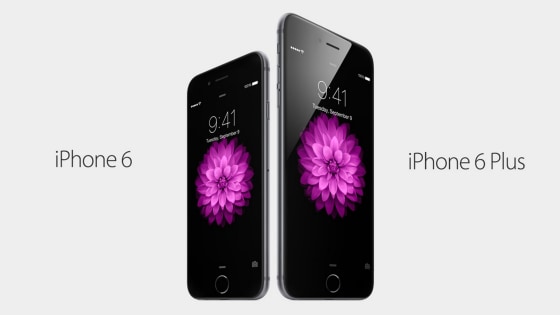Apple’s iPhone 6 was perhaps the most highly anticipated device of 2014. Now, after a long, suspenseful year full of rumors and contradictory reports, the next iPhone is finally here. As expected, Apple will sell two different versions of the iPhone 6: one with a 4.7-inch screen and another with a 5.5-inch screen, called the iPhone 6 Plus.
Here’s everything we know so far about both iPhones:
Bigger, beautiful screens
The smaller iPhone 6 features a 4.7-inch screen with a pixel resolution of 1334 x 750, which amounts to 366 pixels per inch. The entire phone measures just 6.9-millimeters thick. Meanwhile, the iPhone 6 Plus has a 5.5-inch screen with a 1920 x 1080 pixel resolution and measures just 7.1-millimeters thick. Both models feature the super thin design we saw in leaked images before the event. The power button has been moved to the side for easier access one-handed on the two larger iPhones.
Faster, 64-bit A8 processor and M8 coprocessor
The iPhone 6 is powered by a 64-bit A8 processor, which is 25 percent faster than the A7. The A8 offers 50 percent faster graphics performance and is 50 percent more energy efficient than previous iPhones. Apple also added the updated M8 motion coprocessor to the iPhone 6, which pairs well with fitness apps. The M8 can even tell the difference between cycling, running, and other activities to better gauge your performance. It calculates distance and elevation, using a barometer.
Long battery life, VoLTE, and iOS 8
Apple says that the iPhone 6 can last up to 14 hours of 3G talk time, while the iPhone 6 Plus can last for 24 hours of 3G talk time. The iPhone 6 supports 20 LTE bands and supports VoLTE. Users can also make calls over Wi-Fi on select carriers’ networks, including T-Mobile. Of course, both iPhone 6 models will run iOS 8, which will be available for download on September 17 for all iOS users with compatible devices.
Apple Pay mobile wallet
Apple introduced its new mobile payments app, called Apple Pay alongside the iPhone 6. The system works anywhere that mobile payments are already accepted, but Apple’s also worked closely with retailers to bring Apple Pay everywhere. Starbucks, Uber, Panera Bread, Sephora, Walgreens, Disney, Whole Foods, and more will accept Apple Pay. Apple Pay works with Visa, Mastercard, and American Express accounts. It will be available in October.
Sharper camera with better autofocus
Apple also gave the iPhone 6 camera a huge boost. On the back of the device is an 8-megapixel camera with a true-tone flash, 1.5 micron pixels, and a f/2.2 aperture (Apple claims the new camera captures 81 percent more light). The camera also has an iSight sensor and a new Focus Pixels system, which allows for phase-detection autofocusing that is twice as fast as it was before. With phase detection, autofocus is achieved by comparing two images created by incoming light hitting two micro lenses; it helps the camera measure direction and how far to move the lens. This is considered faster and more accurate than what is known as contrast detection.
The iPhone 6 has digital image stabilization, while the iPhone 6 Plus has optical image stabilization (OIS), which is generally accepted as “real” image stabilization (the camera stabilizes a photo by compensating with lens movement, not through software manipulation); image stabilization is also available in movie mode. Both of the iPhones cameras can record video at 1080p at 30 or 60 frames per second. There’s also a Slo-Mo mode that can record at 240 fps. Panoramas can now be shot at up to 43 megapixels. Burst mode can detect smiles and blinks, and then recommend the best photo out of the bunch taken; it can also detect faces better. With these enhanced optics and features, the iPhone is becoming more and more like traditional digital camera in functionality, offering features once found only in higher-end models.
The front camera has also gotten a boost. It now lets you shoot high dynamic range (HDR) photos, and shoot multiple photos in burst mode.
Price and release date
The smaller iPhone 6 with 16GB of storage will start at $200, the 64GB version will cost $300, and the 128GB version will cost $400. Meanwhile, the larger iPhone 6 Plus starts at $300 for the 16GB version, while the 64GB model costs $400, and the 128GB model costs $500. Both models come in gold, silver, and space grey color options. The two iPhones will arrive in stores on September 19, but you can pre-order them online starting September 12.
We’ll continue updating this story with more information as the event continues.
Read more: http://www.digitaltrends.com/mobile/iphone-6-air-features-release-rumors/#ixzz3CpFRfDtw
Follow us: @digitaltrends on Twitter | digitaltrendsftw on Facebook

Comments